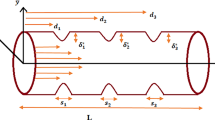Abstract
It has been shown that the resistance of flow and the wall shear increase with the size of the stenosis but these increases are comparatively small due to non-Newtonian behaviour of the blood indicating the usefulness of its rheological character in the functioning of the diseased arterial circulation.
Similar content being viewed by others
Literature
Bergel, D. H., R. M. Nerem and C. J. Schwartz. 1974. “Fluid Dynamic Aspects of Arterial Diseases.” In proceedings of a specialists' meeting at the Ohio State University held Sept. 19–20.
Bird, R. B., W. E. Stewart and E. N. Lightfoot. 1960.Transport Phenomena. New York: Wiley.
Burton, A. C. 1968.Physiology and Biophysics of the Circulation. Chicago: Year Book Medical Publishers Inc.
Caro, C. G., J. M. Fitz-Gerld and R. C. Schroter. 1971. “Atheroma and Arterial Wall Shear Observation, Correlation and Proposal of a Shear Dependent Mass Transfer Mechanism for Atherogenesis.”Proc. R. Soc. B 177, 109–159.
Casson, N. 1959. “A Flow Equation for Pigment Oil Suspensions of the Printing Ink Type.” InRheology of Disperse Systems, Ed. Mill, C.C., pp. 84–102. London: Pergamon Press.
Charm, S. E. and G. S. Kurland. 1962. “Tube Flow Behaviour and Shear Stress/Shear Rate Characteristics of Canine Blood.”Am. J. Physiol. 203, 417.
——. 1965. “Viscometry of Human Blood for Shear Rate of 0–100,000 sec−1.”Nature, Lond.,206, 617–618.
——. 1975.Blood Flow and Microcirculation. New York: Wiley.
Cheng, L. C., M. E. Clark and W. C. Peng. 1977. “The Effect of Oscillatory Frequency in Plane Wavy Conduct Flows.”J. Biomech. 10, 607.
Clark, C. 1977. “Turbulent Wall Pressure Measurement in a Model of Aortic Stenosis.”J. Biomech.,10, 461.
Cokelet, G. R. 1972. “The Rheology of Human Blood.” InBiomechanics, Ed. by Y. C. Funget al., p. 63. Englewood Cliffs: Prentice-Hall.
Eklof, B. and S. I. Schwartz. 1970. “Critical Stenosis of the Carotid Artery in the Dog.”Scand. J. Clin. Lab. Invest.,25, 349–353.
Forrester, J. H. and D. F. Young. 1970. “Flow Through a Converging Diverging Tube and its Implications in Occlusive Vascular Disease.”J. Biomech.,3, 297–316.
Fox, J. A. and A. E. Hugo. 1966. “Localization of Atheroma: A Theory Based on Boundary Layer Separation.”Br. Heart J.,28, 388.
Fry, D. L. 1968. “Acute Vascular Endothelial Changes Associated with Increased Blood Velocity Gradients.”Circulat. Res. 22, 165–197.
— 1972. “Localizing Factors in Arteriosclerosis.” InAtherasclerosis and Coronary Heart Disease, p. 85. New York: Grune & Stratton.
Govier, G. W. and K. Azis. 1972.The Flow of Complex Mixtures in Pipes. New York: Van Nostrand Reinhold.
Haynes, R. H. and A. C. Burton. 1959. “Role of Non-Newtonian Behaviour of Blood in Hemodynamics.”Am. J. Physiol. 197, 943.
Hershey, D., R. E. Byrnes, R. L. Deddens and A. M. Rao. 1964. “Blood Rheology: Temperature Dependence of the Power Law Model.” Paper presented at A.I.Ch.E. meeting, Boston (December).
—, and S. J. Cho. 1966. “Blood Flow in Rigid Tubes: Thickness and Slip Velocity of Plasma Film at the Wall.”J. Appl. Physiol. 21, 27.
Huckaba, C. E. and A. W. Hahn. 1968. “A Generalized Approach to the Modeling of Arterial Blood Flow.”Bull. Math. Biophys. 30, 645–662.
Lee, J. S. 1974. “On the Coupling and Detection of Motion Between an Artery with a Localized Lesion and its surrounding Tissue.”J. Biomech.,7, 403.
—, and Y. C. Fund. 1970. “Flow in Locally Constricted Tubes at low Reynolds Numbers.”J. Appl. Mech.,37, 9–16.
Lih, M. M. 1975.Transport Phenomena in Medicine and Biology. New York: Wiley.
May, A. G., J. A. Deweese and C. B. Rob. 1963. “Hemodynamic Effects of Arterial Stenosis.”Surgery 53, 513–524.
Merrill, E. W., G. R. Cokelet, A. Britten and R. E. Wells. 1963. “Non-Newtonian Rheology of Human Blood Effect of Fibrinogen Deduced by Subtraction.”Circulat. Res.,13, 48.
———. 1964. “Rheology of Human Blood and the Red Cell Plasma Membrane.”Bibl. Anat.,4, 51.
Morgan, B. E. and D. F. Young. 1974. “An Integral Method for the Analysis of Flow in Arterial Stenosis”.Bull. Math Biol. 36, 39–53.
Nerem, R. M. 1974. “Fluid Dynamics Aspects of Arterial Disease.” In proceedings of a specialist's meeting at the Ohio State University held in Sept. 19–20.
Reiner, M. and G. W. Scott Blair. 1959. “The Flow of the Blood Through Narrow Tubes.”Nature, Lond.,184, 354.
Richard, L. K., D. F. Young and N. R. Chalvin. 1977. “Wall Vibrations Induced by Flow Through Simulated Stenosis in Models and Arteries.”J. Biomech.,10, 431.
Rodbard, S. 1966. “Dynamics of Blood Flow in Stenotic Lesions.”Am. Heart J. 72, 698.
Rodkiewitcz, C. M. 1974. “Atherosclerotic Formations in the Light of Fluid Mechanics.” Fluid Engineering Conference, in Montreal, jointly sponsored by the American and Canadian Societies of Mechanical Engineering.
Spain, D. M. 1966. “Atherosclerosis.”Scient. Am. 215, 49.
Texon, M. 1957. “A Hemodynamic Concept of Atherosclerosis with Particular Reference to Coronary Occlusion.”Arch. Int. Med. 99, 418.
Whitmore, R. L. 1968.Rheology of the Circulation. Oxford: Pergamon Press.
Young, D. F. 1968. “Effect of a Time-Dependent Stenosis on Flow Through a Tube.”Trans. ASME., J. Engng. Ind. 90, 248–254.
—, and F. Y. Tsai. 1973. “Flow Characteristics in Models of Arterial Stenosis—II Unsteady Flow.”J. Biomech.,6, 547.
Author information
Authors and Affiliations
Rights and permissions
About this article
Cite this article
Shukla, J.B., Parihar, R.S. & Rao, B.R.P. Effects of stenosis on non-newtonian flow of the blood in an artery. Bltn Mathcal Biology 42, 283–294 (1980). https://doi.org/10.1007/BF02460787
Received:
Revised:
Issue Date:
DOI: https://doi.org/10.1007/BF02460787



